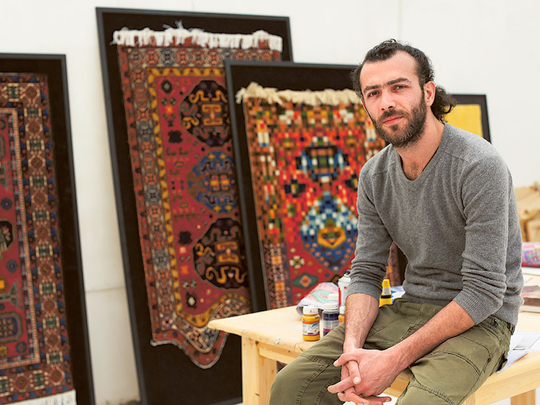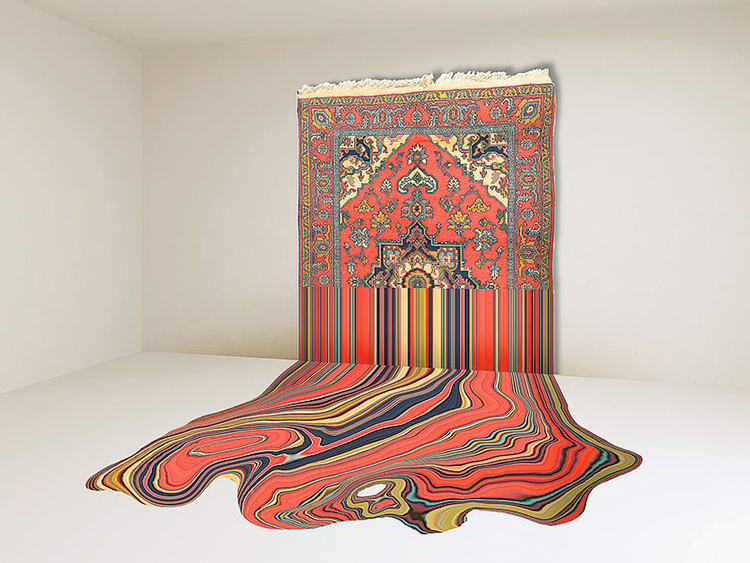
Although Faig Ahmad studied sculpture at the Azerbaijan State Academy of Fine Art in Baku, he works with various media, including painting, video and installation. However, the young artist is now well known for artworks inspired by traditional hand-woven Azerbaijani woollen carpets.
The pieces, made in collaboration with weavers from a small village in Azerbaijan, are created with the same threads, geometric patterns, traditional motifs, colours and techniques that have been used by the weavers for centuries, and handed down from generation to generation.
But the artist gives them a contemporary twist by using digital technology to create new interpretations of the motifs and to play with the classical shape and function of the carpets. His unique artworks challenge viewers to question the role of modern influences in reshaping and repositioning age-old assumptions about tradition and culture.
In his latest show in Dubai, “Fluid Forms”, Ahmad further stretches the conventional idea of a carpet through his experiments with three-dimensional sculptural forms and fluid shapes. He is also exhibiting a work from a new series inspired by traditional Azerbaijani embroidery, and one of his signature “thread” installations. The artist worked on this project during a residency at Cuadro gallery, organised in partnership with Fairmont The Palm.
“During my childhood, I used to see most women in my father’s village weaving and doing embroidery. But sadly, there are just a few weavers and embroiderers left in the village now, because the younger generation is not interested in these crafts. I feel that maybe these traditions will not be lost if we can give them new energy to move forward by contemporising them. So, I used digital technology to create new designs based on the traditional motifs and patterns, and then made detailed sketches for the weavers in the village to translate into woollen rugs,” Ahmad says.
“I grew up in the city, and these people live in a very traditional society in rural Azerbaijan. So it was a meeting of two different worlds. We learnt from each other and inspired each other. Interacting with them gave me a deeper understanding of the traditional carpets and of my culture. And my project revived their interest in this craft by pushing them to stop working mechanically and find innovative ways to create the unusual shapes, gaps and other distortions in my designs,” he adds.
The result is a beautiful blend of traditional craftsmanship and contemporary art. In a piece titled “Impossible Viscosity”, the carpet seems to be forcefully stretched out and almost torn apart with gashes expertly woven into the design. In another work called “Liquid”, the threads flow out from the patterns on the wall-mounted piece to form a river of swirling colours on the floor. In other works too, the threads spill out from the carpets, breaking the symmetry of the pattern, transforming geometric motifs into abstracted ones, and distorting the borders. “The idea is to impart fluidity to something that has a rigid form and function so that it can flow into a new time and space,” Ahmad says.
In another set of works, the artist has focused on individual motifs commonly found in the carpets. The motifs, representing mythological birds, serpents and other creatures, have been digitally enlarged, distorted and transformed into three-dimensional forms that seem to jut out from the carpets, dominating the viewer’s attention and relegating the carpets to the background. The effect is enhanced by the shadows Ahmad has painted on the carpets. “By giving prominence to these contemporary versions of traditional motifs, I want to highlight the importance of modernisation for their survival,” Ahmad says.
The same idea is conveyed in another work, “Shift”, which is inspired by traditional Azerbaijani embroidery. The installation features a sheet of valuable vintage fabric, covered with beautiful embroidery and mounted on a table-like base with legs that are uneven, missing or jutting out from the top. “In the old days, the villagers always put a hand-embroidered tablecloth on the table when guests came over for a meal. But with few embroiderers left in the village, this tradition is dying. I used digital techniques to aggressively pull out and push in the traditional flat patterns and give them a new life. The uneven and missing legs of the frame and the ‘black holes’ into which the embroidery seems to disappear allude to the precarious situation of this traditional craft, and the shift in the balance between old and new,” Ahmad says.
The artist has become well known for his eye-catching “thread” installations, with the threads sometimes running past the gallery walls, on to neighbouring buildings. The installation in this show starts as a traditional embroidery pattern glued on to the wall.
A part of it is unravelled, and the threads emerge from the wall to spread across the room, forming a delicate web of criss-cross patterns extending up to the ceiling.
“This is a visual depiction of the idea that old traditions are not lost, but just transformed to another form. It shows that the threads from the classical patterns have the freedom, fluidity and energy to break the boundaries of tradition, space and time, and continue into the next generation without losing their essence and meaning. And even if the old pattern is destroyed, it is possible to create something new with the same threads, techniques, and motifs. This work is also an apt metaphor for my creative process, which begins with traditional carpets and embroidery, travels into a virtual space, and then connects back with reality in the hands of craftswomen,” the artist says.
Jyoti Kalsi is an arts enthusiast based in Dubai.
“Fluid Forms” will run at Cuadro Gallery, DIFC, until November 30.















